Asus P6T Deluxe - BIOS Setup
The Core i7 920 has a 4.8GT/s QPI and a slower northbridge/Uncore frequency than the Core i7 965, which gives it plenty of overhead to dive into. The Core i7 920 CPU is multiplier locked (only the Extreme Edition 965s are unlocked), so we'll have to increase the QPI frequency to get more MHz.Addendum March 2009: It's come to our attention that retail Core i7 920s now have unlocked memory and QPI buses, although OEM CPUs apparently do not. The CPU multipliers are still locked but the retail CPUs now offer a wealth of higher performance memory and QPI options which we certainly feel are worth investing in.
AI Overclock Tuner - Manual: Although if you're lucky enough to have XMP ready memory you might want to try that - 1,600MHz sets the QPI link to 200MHz - just what we needed for 4GHz, but we still did it manually anyway.
Intel Turbo Mode - Disable: We disabled it so as it would not interfere with the overclock, however we left on the new Intel low power states. Normally this affects how the CPU overclocks and in extreme cases we expect it will, because the on/off effect to the CPU frequency and voltages as the C-state changes.
Intel has stopped multiplier dropping its CPUs like it does with Penryn, instead it just turns the clocks and cache off in stages to reduce power of the cores. However considering the CPU has a 130W TDP before overvolting and overclocking, we didn't quite fancy running it all guns blazing all the time (we still need the CPU for future testing!). We found the on-board power microcontroller built into the Nehalems seems to handle its C-state changes far more stably than Penryn (which requires more motherboard intervention), even when the overclock is 50 percent.
BCLK Frequency - 200(MHz): BCLK = Base clock. This affects the QPI and uncore (L3 cache, northbridge) frequency too - some motherboards like the Intel Smackover allow the ratios to be adjusted, but the Asus does not. Here the ratio is 18x for the QPI and 16x for the uncore (northbridge/L3 cache). The uncore frequency must also always be below the QPI, we’re told.
DRAM Frequency - 1,600MHz: Although if you don't have uber-ram, set it to the lower frequency as the bandwidth will still be super-sized regardless.
CPU Voltage - 1.35V: We found this was plenty, depending on your own CPU's needs, it might be happy using less.
CPU PLL Voltage - 1.96V: In all honesty, we've got to play with this function more, but a 0.16-0.2V increase worked for Penryn so we're also using it here.
 QPI/DRAM Voltage - 1.35V: This is poorly worded by Asus - it should read uncore or QPI/memory controller voltage so not to confuse it with the actual memory voltage. Increasing this is also necessary as it helps overclock the base frequency as the uncore area overclocks increase in relation to the CPU core overclocks. This voltage is tied to actual DRAM voltage - the two are directly connected on the motherboard. You'll need to increase this to keep the CPU safe.
QPI/DRAM Voltage - 1.35V: This is poorly worded by Asus - it should read uncore or QPI/memory controller voltage so not to confuse it with the actual memory voltage. Increasing this is also necessary as it helps overclock the base frequency as the uncore area overclocks increase in relation to the CPU core overclocks. This voltage is tied to actual DRAM voltage - the two are directly connected on the motherboard. You'll need to increase this to keep the CPU safe. While Asus and Intel (rightly) scare everyone (read: uneducated) into thinking that 1.65V on the DRAM voltage should be the absolute limit before you reach for the fire-blanket, all that's really needed it to obey this: keep the CPU uncore voltage within 0.5V difference of the DRAM voltage and there's no problem. Over this potential difference and you’ll greatly increase the chance of CPU death, but it certainly won't happen instantly in a big ball of
DRAM Voltage - 1.66V: This is the closest to the 1.65V the Corsair Dominator DIMMs wanted and it's within the 0.5V Uncore difference.
If you are familiar with Intel systems, the best thing to do is treat QPI frequency like you would Front Side Bus and cranking up the QPI also levies another advantage - increased memory frequencies. Because the Core i7 920 uses the basic 4.8GT/s QPI frequency there is no option available here to adjust it, so you don't have to worry about it, however being able to see what its "final frequency" post-overclock would be incredibly useful.
A little extra differential amplitude because Asus claims in the BIOS that it helps with overclocking and perhaps turning off some unused features like Virtualisation is worth it as well, but keeping the pre-fetchers and HyperThreading on will improve performance.
We found that enabling the HPET (High Performance Event Timer), or as Asus label it, APCI 2, is critical for keeping the clocks on Core i7 CPUs accurate. Without it turned on, the multiplier jumps around crazily if we watch CPU-Z, but with it on, the multiplier reading is solid and the clock frequency only jitters very slightly according to fractional variations in the base clock.

MSI MPG Velox 100R Chassis Review
October 14 2021 | 15:04


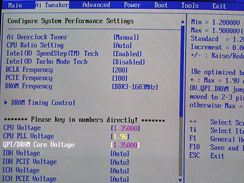
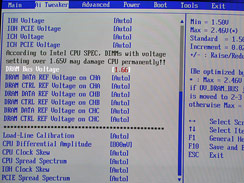
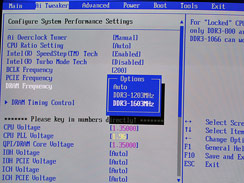
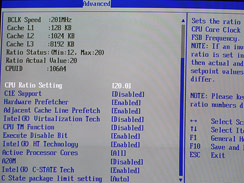
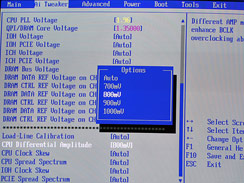
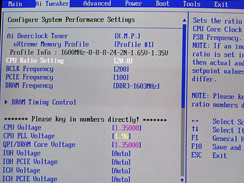







Want to comment? Please log in.